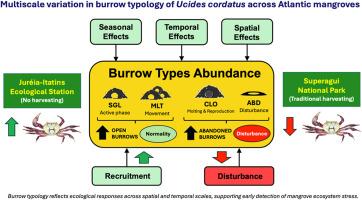大西洋红树林梭鲈洞穴类型和丰富度的多尺度变化:时间、空间和气候的影响
IF 2.6
3区 地球科学
Q1 MARINE & FRESHWATER BIOLOGY
引用次数: 0
摘要
了解跨时空尺度的生态过程对于解释种群动态和指导保护工作至关重要。然而,对十足甲壳类动物种群的多尺度影响仍未得到充分探索。研究了巴西两个受保护的红树林生态系统:jur本文章由计算机程序翻译,如有差异,请以英文原文为准。

Multiscale variation in the burrow typology and abundance of Ucides cordatus across Atlantic mangroves: effects of time, space, and climate
Understanding ecological processes across spatial and temporal scales is crucial for interpreting population dynamics and guiding conservation efforts. However, multiscale influences on decapod crustacean populations remain underexplored. We investigated the variability in Ucides cordatus burrow typologies across two protected Brazilian mangrove ecosystems: Juréia-Itatins Ecological Station (JIES) and Superagui National Park (SNP). Sampling involved 120 quadrats (5 × 5 m each), with five quadrats allocated to each mangrove zone (fringe and apicum) at both conservation units, during summer and winter seasons over three consecutive years (2016–2018). Generalised linear models tested the effects of year, season, site, and tidal zone on the abundance of five burrow types: SGL (single-opening), MLT (multi-opening), OPE (sum of SGL and MLT), CLO (closed), and ABD (abandoned). We observed marked interannual and seasonal variability, especially under climatic anomalies, along with spatial contrasts driven by tidal flooding patterns and microhabitat structure. Burrow types reflected distinct functional phases: SGL and MLT were linked to active behaviour and responded sharply to environmental variation; CLO was associated with reproduction or moulting; ABD indicated environmental stress or recolonisation. Fringe zones exhibited greater variability and reduced open burrow abundance under stressful conditions. Integrating burrow typologies with spatiotemporal factors proved an effective, non-invasive approach for detecting ecological shifts and assessing habitat quality. Our findings reinforce the role of U. cordatus as a bioindicator species and support the use of burrow-based metrics in the long-term monitoring and conservation of mangrove ecosystems facing increasing climatic and anthropogenic pressures.
求助全文
通过发布文献求助,成功后即可免费获取论文全文。
去求助
来源期刊
CiteScore
5.60
自引率
7.10%
发文量
374
审稿时长
9 months
期刊介绍:
Estuarine, Coastal and Shelf Science is an international multidisciplinary journal devoted to the analysis of saline water phenomena ranging from the outer edge of the continental shelf to the upper limits of the tidal zone. The journal provides a unique forum, unifying the multidisciplinary approaches to the study of the oceanography of estuaries, coastal zones, and continental shelf seas. It features original research papers, review papers and short communications treating such disciplines as zoology, botany, geology, sedimentology, physical oceanography.

 求助内容:
求助内容: 应助结果提醒方式:
应助结果提醒方式:


